Quarterly Market Review – Q3 – 2017
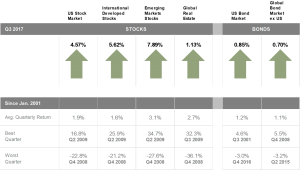
Click on the link below for a detailed analysis of quarterly performance of the global equity and fixed income markets.
CLICK HERE TO READ THE 3RD QUARTER 2017 – QUARTERLY MARKET REVIEW

Click on the link below for a detailed analysis of quarterly performance of the global equity and fixed income markets.
CLICK HERE TO READ THE 3RD QUARTER 2017 – QUARTERLY MARKET REVIEW
“I have found that the importance of having an investment philosophy—one that is robust and that you can stick with— cannot be overstated.”
—David Booth
The US stock market has delivered an average annual return of around 10% since 1926.[1] But short-term results may vary, and in any given period stock returns can be positive, negative, or flat. When setting expectations, it’s helpful to see the range of outcomes experienced by investors historically. For example, how often have the stock market’s annual returns actually aligned with its long-term average?
Exhibit 1 shows calendar year returns for the S&P 500 Index since 1926. The shaded band marks the historical average of 10%, plus or minus 2 percentage points. The S&P 500 had a return within this range in only six of the past 91 calendar years. In most years the index’s return was outside of the range, often above or below by a wide margin, with no obvious pattern. For investors, this data highlights the importance of looking beyond average returns and being aware of the range of potential outcomes.
S&P 500 Index Annual Returns
1926–2016

[1]. As measured by the S&P 500 Index from 1926–2016.
In US dollars. The S&P data are provided by Standard & Poor’s Index Services Group. Indices are not available for direct investment; therefore, their performance does not reflect the expenses associated with the management of an actual portfolio. Past performance is not a guarantee of future results. Index returns do not reflect the cost associated with an actual investment.
TUNING IN TO DIFFERENT FREQUENCIES
Despite the year-to-year uncertainty, investors can potentially increase their chances of having a positive outcome by maintaining a long-term focus. Exhibit 2 documents the historical frequency of positive returns over rolling periods of one, five, 10, and 15 years in the US market. The data shows that, while positive performance is never assured, investors’ odds improve over longer time horizons.
Frequency of Positive Returns in the S&P 500 Index
Overlapping Periods: 1926–2016
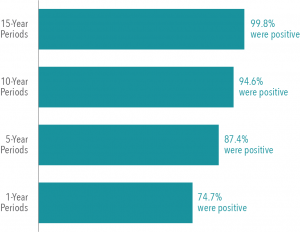
From January 1926–December 2016 there are 913 overlapping 15-year periods, 973 overlapping 10-year periods, 1,033 overlapping 5-year periods, and 1,081 overlapping 1-year periods. The first period starts in January 1926, the second period starts in February 1926, the third in March 1926, and so on. In US dollars. The S&P data are provided by Standard & Poor’s Index Services Group. Indices are not available for direct investment; therefore, their performance does not reflect the expenses associated with the management of an actual portfolio. Past performance is not an indication of future results.
Conclusion
While some investors might find it easy to stay the course in years with above average returns, periods of disappointing results may test an investor’s faith in equity markets. Being aware of the range of potential outcomes can help investors remain disciplined, which in the long term can increase the odds of a successful investment experience. What can help investors endure the ups and downs? While there is no silver bullet, having an understanding of how markets work and trusting market prices are good starting points. An asset allocation that aligns with personal risk tolerances and investment goals is also valuable. Financial advisors can play a critical role in helping investors sort through these and other issues as well as keeping them focused on their long‑term goals.

When you’re laying the foundation for your retirement, the first big step is choosing your deferral rate. When you say it that way, it seems easy. What if I said, “how much of your paycheck will you sacrifice now for your future self?”
Your 401(k) contribution rate will set the financial tone for your retirement plan. First let’s start with the factors that go into this determination:
It’s clear that savers are at different points in their careers and lives. There is not a magic number. But everyone can take steps to get to the optimal amount of savings. There are many factors that can help you determine your deferral rate. This checklist is a good place to start:
Conclusion: Make a commitment to pay yourself first and take advantage of free money from your employer. Stay disciplined and work toward a goal of increasing your deferral every year. When selecting a deferral rate, aim higher rather than lower! You’ll thank yourself later! If this process seems overwhelming, a financial advisor can help you determine the best rate for your situation.

Many investors, including retirees, rely on their investment portfolio to fund their cash needs. This need can be approached in one of two ways. In this blog, we explore the yield vs. total return approaches to generating income in a portfolio, and address misconceptions about the benefits of emphasizing dividend and interest income at the expense of other portfolio issues.
Using Interest and/or Dividends from securities to fund cash flow needs
The traditional appeal to this method stems from the belief that stocks paying high dividends are less risky because they offer a regular stream of payments to investors. Before you determine this is the favorable route, keep in mind that the amount of dividend and interest income generated by a portfolio is largely determined by dividend policies of the firms and prevailing market interest rates. Both of these are variables outside an investor’s control. Dividend payments are not created out of thin air. They flow from a company’s earnings or assets, which are reflected in the current stock price.
DID YOU KNOW when a company pays a dividend, its stock price is reduced by an amount approximately equal to the dividend itself? So even when accounting for the cash received, the portfolio value may remain unchanged. While you may not have to liquidate assets for cash flow, the economic impact may be essentially the same.
The key is not to allow your preference for yield to influence your asset allocation by focusing on securities with higher yields. Let’s look at the numbers:
Focusing on TOTAL RETURN to create cash flow
This type of portfolio involves selling assets in the portfolio to create cash flow. This method reflects the idea that, from an investment standpoint, it makes little difference whether returns are delivered as dividends or capital gains. Selling assets also allows greater control over the amount of cash flow generated, and eliminates reliance on dividend yields and interest rates, which are uncontrollable. It may create an opportunity to strategically rebalance by selling assets that are over-weighted relative to the target allocation.
If you follow iconic investor Warren Buffet, you may know that he also believes in the Total Return Strategy. His company, Berkshire Hathaway, has never paid a dividend. His belief is that investors can sell shares if cash is needed, with a timed sale that can capture optimal tax rates. His strategy is to keep the cash in the company, prevent dividends from being double taxed, and use that cash to fund future investments into the company.
CONCLUSION
Investors can have much greater control in generating cash flows by selling securities rather than relying on dividend and interest income. Firms’ payout policies evolve over time, as do market interest rates. Rather than letting portfolio yields determine spending rates, investors can develop a sustainable withdrawal strategy with a financial advisor. If you plan to rely on interest income for cash flow, consider your overall fixed income needs in your portfolio first. Contact us to set up a free portfolio evaluation, and take the first step to a long-term plan. Don’t let an income bias affect your diversification or expected returns.

Recently, many companies have added a Roth option to their 401(k) plans. Should you put your money into a traditional 401(k) or opt for a Roth 401k)? Let’s analyze the differences between the two by first taking a quick quiz:
1. Will I be in a higher tax bracket today, or when I retire?
2. Is there a chance I’ll need to withdraw before age 59 ½?
It’s possible to make an unqualified withdrawal, that is, a withdrawal before age 59 ½ that’s not on the list of exceptions. No matter whether you have a traditional or Roth 401(k), you have to pay income tax on the withdrawal, plus a 10% early distribution penalty. However, traditional withdrawals are taxed on the full amount, whereas Roth withdrawals only tax the earnings.
Hopefully, you will never have to make an early, unqualified withdrawal from your 401(k) and you can let the money grow in your account until you retire. However, life happens and if you want the flexibility of being able to withdraw without as steep a tax penalty, a Roth 401(k) may be a better fit for you. Keep in mind, any employer contributions will be taxed as regular income upon withdrawal, no matter they type of 401(k) you choose.
3. Is there a time (before retirement) when I’ll be making less than I am now?
In sum, Roth and traditional 401(k) accounts have similarities and differences. Depending on your current and future tax bracket, need for early distributions, and desire to roll over accounts, one type of retirement account may be more beneficial than the other. One option would be to contribute to both to add to your tax savings flexibility (tax diversification).
The best place to start is with a financial advisor that can dig deeper into your current and potential situation. Our retirement calculators allow us to calculate the benefits of many different scenarios, for clients in all situations. Please feel free to contact us for a free analysis of your financial options and to help connect your choices to your personal situation.
COSTS MATTER. Whether you’re buying a car or selecting an investment strategy, the costs you expect to pay are likely to be an important factor in making any major financial decision.
People rely on a lot of different information about costs to help inform these decisions. When you buy a car, for example, the sticker price tells you approximately how much you can expect to pay for the car itself. But the sticker price is only one part of the overall cost of owning a car. Other things like sales tax, the cost of insurance, expected routine maintenance costs, and the potential cost of unexpected repairs are also important to understand. Some of these costs are easily observed, and others are more difficult to assess. Similarly, when investing in mutual funds, different variables need to be considered to evaluate how cost‑effective a strategy may be for a particular investor.
Expense ratios
Many types of costs lower the net return available to investors. One important cost is the expense ratio. Similar to the sticker price of a car, the expense ratio tells you a lot about what you can expect to pay for an investment strategy. Exhibit 1 helps illustrate why expense ratios are important and shows how hefty expense ratios can impact performance.
This data shows that funds with higher average expense ratios had lower rates of outperformance. For the 15-year period through 2016, only 9% of the highest-cost equity funds outperformed their benchmarks. This data indicates that a high expense ratio is often a challenging hurdle for funds to overcome, especially over longer horizons. From the investor’s point of view, an expense ratio of 0.25% vs. 0.75% means savings of $5,000 per year on a $1 million account. As Exhibit 2 helps to illustrate, those dollars can really add up over longer periods.
Exhibit 1. High Costs Can Reduce Performance, Equity Fund Winners and Losers Based on Expense Ratios (%)
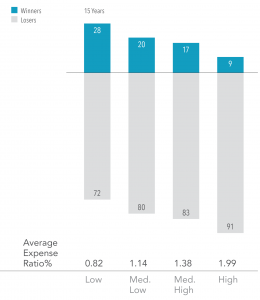
Exhibit 2. Hypothetical Growth of $1 Million at 6%, Less Expenses
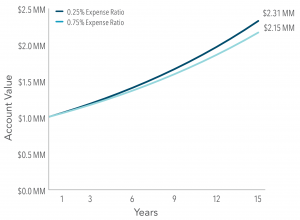
For illustrative purposes only and not representative of an actual investment.
While the expense ratio is an important piece of information for an investor to evaluate, what matters most when gauging the true cost‑effectiveness of an investment strategy is the “total cost of ownership.” Similar to the car example, total cost of ownership is more holistic than any one figure. It looks at things that are readily observable, like expense ratios, but also at things that are more difficult to assess, like trading costs and tax impact. It is important for investors to be aware of these and other costs and to realize that an expense ratio, while useful, is not an all‑inclusive metric for total cost of ownership.
Trading costs
For example, while an expense ratio includes the fund’s investment management fee and expenses for fund accounting and shareholder reporting (among other items), it doesn’t include the potentially substantial cost of trading securities within the fund. Overall trading costs are a function of the amount of trading, or turnover, and the cost of each trade. If a manager trades excessively, costs like commissions and the price impact from trading can eat away at returns. Viewed through the lens of our car analogy, this impact is similar to excessively jamming your brakes or accelerating quickly. By regularly demanding immediacy like this when it may not be necessary, the more wear and tear your car is likely to experience and the more fuel you will end up using. These actions can increase your total cost of ownership. Additionally, excessive trading can also lead to negative tax consequences for the fund, which can increase the cost of ownership for investors holding funds in taxable accounts. The best way to try to decrease the impact of trading costs is for funds to avoid trading excessively and pay close attention to effectively minimizing cost per trade. Employing a flexible investment approach that reduces the need for immediacy, thereby enabling opportunistic execution, is one way to potentially help accomplish this goal. Keeping turnover low, remaining flexible, and transacting only when the potential benefits of a trade outweigh the costs can help keep overall trading costs down and help reduce the total cost of ownership.
Conclusion
The total cost of ownership of a mutual fund can be difficult to assess and requires a thorough understanding of costs beyond what an expense ratio can tell investors on its own. A good advisor can help investors look beyond any one cost metric and instead evaluate the total cost of ownership of an investment program—and ultimately help clients decide if a given strategy is right for them.

Funding your future can be extremely daunting and confusing. One of the hardest expenses to plan for in retirement, could also be the largest one. Young or old, it’s crucial to plan for steep medical expenses and avoid the health care sticker shock that awaits. Medication costs continue to rise, and the out-of-pocket costs for other preventative services are astronomical. Over time, health care costs could exceed Social Security payments. And when we really break it down, it’s clear many Americans won’t be able to afford that once it happens. Let’s break down the problems and solutions:
1. Inflation is not keeping up with Health Care costs
Health-care costs for retirees are likely to increase an average of 5.5% annually over the next decade, which is triple the average inflation rate for the past 4 years, and double the cost of living adjustment on Social Security benefits. A worker 10 years from retirement should prepare, and person 20-30 years from retirement should beware. To put these numbers into context: if a 65 year old couple retired today, they would spend almost $30,000 more in total lifetime retirement health care expenses than a couple who retired in 2016.
2. Health care costs are rising faster than Social Security, so don’t expect Social Security to go very far
Reports have shown that a 66-year-old couple retiring in 2017 will need 59% of their Social Security benefits to cover all retirement health care costs. That doesn’t leave much left over for the fun you’ve been dreaming of. While some retirees can wait to withdraw Social Security until it pays more, it won’t completely close this gap. The cost of living adjustments simply aren’t mirroring the inflation of health care costs. And Social Security is a main source of income for most retirees.
It’s also very important to plan for Long-term care. Depending on how prepared you are for a long-term stay in a health care facility, you may need $75,000 – $90,000 per year for a private room in a long-term care facility.
3. Health care will cost $300,000 – $500,000
Health care will be one of the most significant retirement costs. Lifetime health care premiums will hit well over $300,000 for a healthy 65-year-old couple who retire in 2017. These estimates are just a starting point. When adding deductibles, copays, and other out-of-pocket costs into the mix, that number grows to over $400,000 in today’s dollars, if you’re healthy.
4. Prescription drugs will drain your budget
Anyone who makes regular trips to the pharmacy can educate the masses about the rising costs of prescription drugs. You can anticipate this cost increase to continue for the foreseeable future.
5. A longer lifespan will be expensive, especially for women
Advanced medicine and increased societal awareness has increased our life expectancy, and in turn increased the number of years we are paying for health care. Along those lines, we know that women will face higher lifetime health care costs because, they are expected to live on average two years longer than men.
At Park + Elm, we often talk about having a clear focus on the things we can control. So let’s assume 1-5 above are constants, and begin to prepare by controlling the things we can change. There are strategies to combat the issue of health care in retirement:
1. Take better care of yourself; Modify your physical behavior.
Managing your health, exercising and making health conscious decisions make health care more affordable. Making small lifestyle changes now, such as stopping tobacco use, exercising, maintaining cholesterol, could save several thousand dollars prior to retirement.
2. Start a Health Savings Account (HSA)
Most people aren’t aware that HSA’s can be kept into retirement to help offset medical costs. This is an opportunity to TRIPLE dip for tax purposes. Contributions to an HSA are tax deductible, investment growth is tax deferred, and withdrawals for qualified medical expenses are tax free. This is NOT a “use it or lose it” account, so contributions can be carried over for healthcare in the near or distance future.
3. Commit to a long-term savings plan
Those who start saving for retirement early will find it’s much more manageable to maintain their preferred lifestyle and pay for necessary expenses simultaneously. Even the smallest contributions can make a big impact throughout a lifetime. Take advantage of employer contribution plans and additional investment strategies to make the most of your savings plan. When calculating how much you need to retire, make sure to add at least $300,000 for health care. This is why planning well in advance for a successful retirement is so important
Trying to predict what will happen to Social Security and Medicare has proved to be way to difficult a task. What we know for sure is that there is a gap in Medicare coverage for copays, prescriptions, etc., and that gap needs to be factored into your long-term plan. We know that health care premiums are on the rise, and so are life expectancies. A financial advisor can help you create a long-term strategy to cover the gaps in insurance, and help you achieve peace of mind, so that you can retire with health coverage and enough funds to enjoy your non-working years.
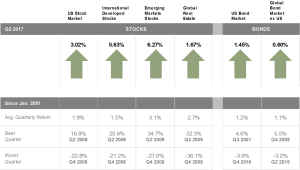
This report features world capital market performance and a timeline of events for the past quarter and the past year. It begins with a global overview, then features the returns of stock and bond asset classes in the US and international markets.
The report also illustrates the impact of globally diversified portfolios and features a quarterly topic.
CLICK BELOW!

It’s a money question that has no definitive answer: “How much should I save for retirement?” An exact figure is so elusive because everybody’s financial situation is different. In the past, most investors blindly considered 1 million dollars to be the number to target. Unfortunately, $1,000,000 could be considered a starting point for some.
It’s not a universal number. But a basic target can be calculated based upon your individual needs. Put more simply…multiply your current gross pay by 80%. This is a reliable factor for retirement spending. It’s not necessarily perfect. Spending tends to go down in retirement, but not for everyone. There are those that are planning large retirement purchases and spending. But a comfortable retirement can be expected at this spending rate. Exhibit 1 below offers a specific example for a current income of $65,000/year.
Exhibit 1
Current annual income = $65,000
Anticipated annual Spending = $52,000 (Current Income x 80%)
Other sources of Income = $20,000 (Pension, Social Security, Part-time work)
Needed from Investments = $32,000 (Anticipated spending less other sources)
Retirement Goal = $800,000 (Needed from Investments x 25)
If you’re overwhelmed by how much money you should have before retiring, start with your expenses. Focus on the expenses you can control. Naturally, the less money you spend on an annual basis, the less money you’ll need to retire.
It’s not a matter of luck. Your expenses determine if you can truly afford retirement. Sure, we don’t know exactly how much we’ll spend on an annual basis in the future, but most of us can reduce several major expenses like housing, transportation, and food if we truly tried.
The above exhibit is a very simplistic example of how to start the planning process. There are other items, like health care, that need consideration. Most people never start this process, because there are so many variables to consider. A financial adviser can help you create a strategy for savings, as well as a distribution strategy after your working years. There are several factors to be considered on your way to an enjoyable retirement. Please contact us for a complimentary investment projection and distribution strategy.
Should stock investors worry about changes in interest rates?
Research shows that, like stock prices, changes in interest rates and bond prices are largely unpredictable. It follows that an investment strategy based upon attempting to exploit these sorts of changes isn’t likely to be a fruitful endeavor. Despite the unpredictable nature of interest rate changes, investors may still be curious about what might happen to stocks if interest rates go up.
Unlike bond prices, which tend to go down when yields go up, stock prices might rise or fall with changes in interest rates. For stocks, it can go either way because a stock’s price depends on both future cash flows to investors and the discount rate they apply to those expected cash flows. When interest rates rise, the discount rate may increase, which in turn could cause the price of the stock to fall. However, it is also possible that when interest rates change, expectations about future cash flows expected from holding a stock also change. So, if theory doesn’t tell us what the overall effect should be, the next question is what does the data say?
Recent research performed by Dimensional Fund Advisors helps provide insight into this question. The research examines the correlation between monthly US stock returns and changes in interest rates. Exhibit 1 shows that while there is a lot of noise in stock returns and no clear pattern, not much of that variation appears to be related to changes in the effective federal funds rate.
Exhibit 1. Monthly US Stock Returns against Monthly Changes in Effective Federal Funds Rate, August 1954–December 2016
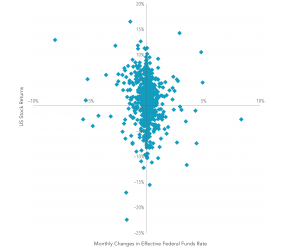
Monthly US stock returns are defined as the monthly return of the Fama/French Total US Market Index and are compared to contemporaneous monthly changes in the effective federal funds rate. Bond yield changes are obtained from the Federal Reserve Bank of St. Louis.
For example, in months when the federal funds rate rose, stock returns were as low as –15.56% and as high as 14.27%. In months when rates fell, returns ranged from –22.41% to 16.52%. Given that there are many other interest rates besides just the federal funds rate, Dai also examined longer-term interest rates and found similar results.
So to address our initial question: when rates go up, do stock prices go down? The answer is yes, but only about 40% of the time. In the remaining 60% of months, stock returns were positive. This split between positive and negative returns was about the same when examining all months, not just those in which rates went up. In other words, there is not a clear link between stock returns and interest rate changes.
Conclusion
There’s no evidence that investors can reliably predict changes in interest rates. Even with perfect knowledge of what will happen with future interest rate changes, this information provides little guidance about subsequent stock returns. Instead, staying invested and avoiding the temptation to make changes based on short-term predictions may increase the likelihood of consistently capturing what the stock market has to offer.
Source: Dimensional Fund Advisors LP